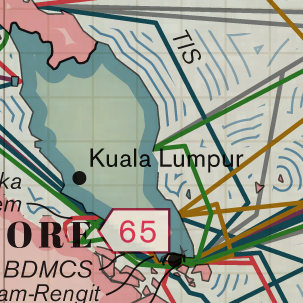 A good friend and regular reader (or so I hope) of this blog sent me this link last week. It’s a really nifty chart of all the undersea cables in the world. Now, for those who don’t know what undersea cables are, they’re basically the huge data cables that carry around the data we use for the internet. While modern satellites orbit overhead, the unfortunate truth is that satellites aren’t able to carry even a fraction of the bandwidth that undersea cables do, and chances are if you’re reading this now–at least some of this data has gone through an undersea cable before ending up on your screen.
A good friend and regular reader (or so I hope) of this blog sent me this link last week. It’s a really nifty chart of all the undersea cables in the world. Now, for those who don’t know what undersea cables are, they’re basically the huge data cables that carry around the data we use for the internet. While modern satellites orbit overhead, the unfortunate truth is that satellites aren’t able to carry even a fraction of the bandwidth that undersea cables do, and chances are if you’re reading this now–at least some of this data has gone through an undersea cable before ending up on your screen.
If you look at the moment from an abstract level however, you begin to notice that these cables tend to ‘cluster’ around certain areas. We can see clear clusters in America, but more specifically in states like California, Florida, New Jersey and Oregon. Other places we see clusters are in Brazil, particularly Sao Paolo, and then we huge clusters in the UK (and zooming in you’ll see there’s huge connectivity to Ireland), Portugal and a large amount of cables going through the Suez Canal. In Asia, we see huge metropolis of these things in Japan, Korea, Shanghai and Taiwan, and finally much closer to home we see a huge clustering happening next door–in Singapore and a tiny bit of clustering happening in Sydney, Australia.
So what does this have to do with anything, well consider the location where you can get Amazon instances:
1. Northern Virginia (very close to New Jersey)
2. Oregon
3. Northern California
4. Singapore
5. Sydney
6. Sao Paolo
7. Ireland
Now besides Northern Virginia, all 6 locations where you can get Amazon cloud services are areas that correspond to huge clusters on the map. This is where the internet is. Cloud providers like Amazon need to be where you have redundant high speed internet connectivity — and that means being in an area with a huge amount of ‘clustering’.
Why I bring this up of course, is to show that the cloud providers go to where the infrastructure is, and if we want to entice them to setup their huge Datacenters in Malaysia, we need some clustering to happen on our shores as well. This is the reason I get really angry when people ask Why can’t the next Facebook or Google come from Malaysia, or Why can’t we become the next global IT Hub — we can’t–simply because the infrastructure isn’t there.
To think that Facebook and Google appeared out of nowhere is just foolish, Facebook and Google are a natural consequence of thousands (if not millions) of start ups trying (and failing) in the silicon valley, and sometimes merely on chance you get these big giants who pop up from the dwarfs. The Infrastructure in the valley far exceed anything we have in Malaysia, not just the technical infrastructure, but things like seed money from venture capitalist, proper experience as well as human capital. Malaysia lacks all these things, and we won’t be producing any technological giant till we get our act together on these fronts.
To hope that somehow we’d suddenly get a Google or Facebook by simply throwing money at some startups is both foolish and short-sighted. We lack all the basic ingredients for a startup to succeed and yet we think miraculously we’ll get what we want by throwing money.
In order to create a startup culture, what you first need is the infrastructure to support all ‘startuppy’ culture and attitude.
Coming back to the cables though, I wrote before about where the internet ‘is’, and how the government wants Malaysia to capture a 1% share of the global cloud computing market. From this diagram it’s painfully clear why we’ll continue to fail on that front until someone in a policy decision-making role, wises up and understands the importance of infrastructure.
*for a different look on the same data, try out Gregs Cable map at : www.cablemap.info
[…] to have their data center in far more expensive Singapore, then it Malaysia? Could it be that the communications infrastructure in Singapore far exceeds anything Malaysia currently has–or is planning to have? Could it be that top-notch IaaS providers are less interested in […]
[…] have the cloud servers because we don’t have the cables. I explored this before how cloud computing ties in closely with your data connectivity as a nation–and there really is nothing much we can do to address the gap with Singapore […]